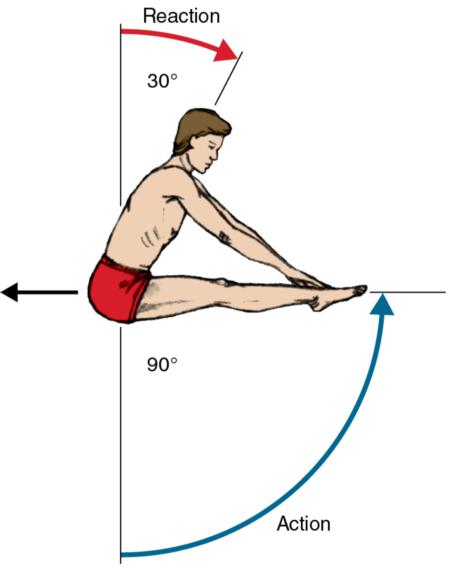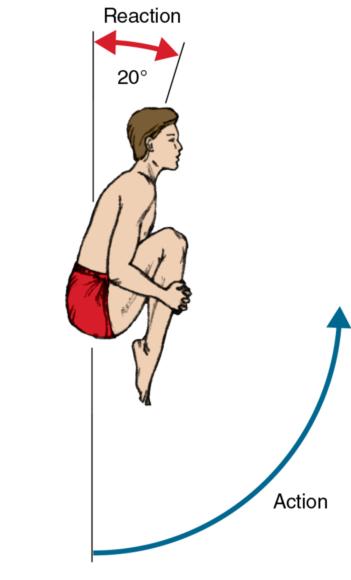Making use of angular momentum
This is an excerpt from Applied Sport Mechanics 4th Edition With Web Resource by Brendan Burkett.
When tower or springboard divers are in flight, they no longer have a large mass to push against. Any muscular action they perform while in the air causes an equal and opposite reaction to occur elsewhere in their bodies. All divers, gymnasts, and other high-flying athletes experience this phenomenon.
For example, imagine a diver stepping off the tower and dropping toward the water in an upright position. In this position, he is not rotating. As the diver drops, imagine the coach shouting for him to raise his extended legs 90° from perpendicular (i.e., pointing directly downward) to horizontal. The muscles that rotate his legs forward and upward around the hip joint pull equally at both origin and insertion (i.e., at either end of the muscle) and therefore simultaneously pull down on his trunk. As a result, during the period that the diver's legs rotate upward, his trunk must rotate downward. Do his legs and trunk rotate in equal-size arcs?
No, because they do not have the same rotary inertia. The rotary inertia of the diver's trunk and upper body is approximately three times that of his legs. Therefore, his trunk and upper body resist rotation three times more than his legs do. When the diver's legs move upward 90° to a horizontal position, the trunk and upper body, which have three times more rotary resistance, move downward in an arc a third of the size, or approximately 30° (see figure 7.8).

Figure 7.8 When the diver's extended legs are raised 90° in a counterclockwise direction, the upper body reacts by moving 30° in a clockwise direction.
The movement of the diver's legs and that of his trunk and upper body may not seem like equal and opposite reactions, yet they are. In our example, the action is the 90° arc moved in a counterclockwise direction by the diver's legs. The reaction is the 30° arc moved in a clockwise direction by their trunk and upper body. This reaction is equal to the action because the diver's trunk and upper body have three times the rotary inertia of the legs. The reaction is opposite because the movement of the trunk and upper body is in the opposing direction to that of the legs.
We've seen that rotary inertia depends not only on how much mass is involved but also on how it is distributed relative to its axis. In the previous example, the diver keeps his legs extended throughout their 90° movement. If the diver flexes at the knees and lifts at the thighs, then the rotary inertia of the legs is reduced. The reaction of the trunk and upper body is also reduced. The upper body and trunk flex approximately 20° (see figure 7.9).

Figure 7.9 When the diver's flexed legs are raised, they have less rotary inertia than when they are raised in an extended position. The upper-body response is less.
Figure 7.10 shows that another reaction will occur in the diver's movements. Notice that as the diver's extended legs rotate counterclockwise, the trunk and upper body rotate clockwise. In the illustration, these body parts move toward the right as you look at them. In the air, body mass moving to the right is counterbalanced by body mass moving to the left. In our example the diver's buttocks and hips react (equal and opposite) by moving toward the left.

Figure 7.10 In the air, when the lower and upper body flex forward, the hips react by shifting backward
This phenomenon of equal and opposite reactions occurring in the air is visible in many sports. A flop-style high jumper always arches to clear the bar. Figure 7.11 shows a high jumper arching the upper body down toward the pit in a counterclockwise direction. The legs respond (equal and opposite) by moving in a clockwise direction. Although upper body and legs are moving in opposing directions, both are moving down toward the pit. So the hips react by moving upward. By correctly timing this action, the high jumper can pass over the bar. The hips and buttocks move upward to help the athlete clear the bar.

Figure 7.11 The high jumper's hips lift upward when the upper and lower body flex downward.
Ty Allison/Photographer's Choice/Getty Images
Learn more about Applied Sport Mechanics, Fourth Edition.
More Excerpts From Applied Sport Mechanics 4th Edition With Web ResourceSHOP

Get the latest insights with regular newsletters, plus periodic product information and special insider offers.
JOIN NOW


